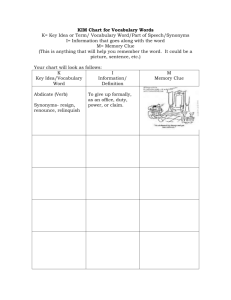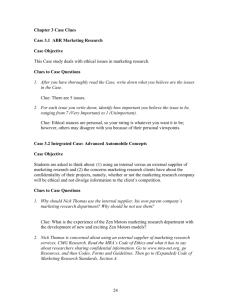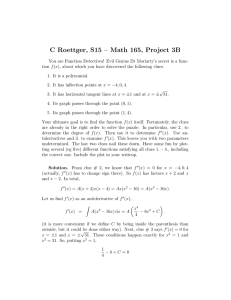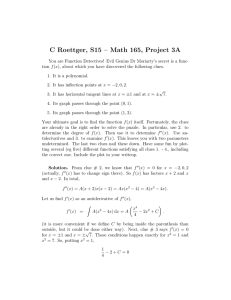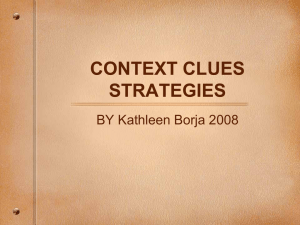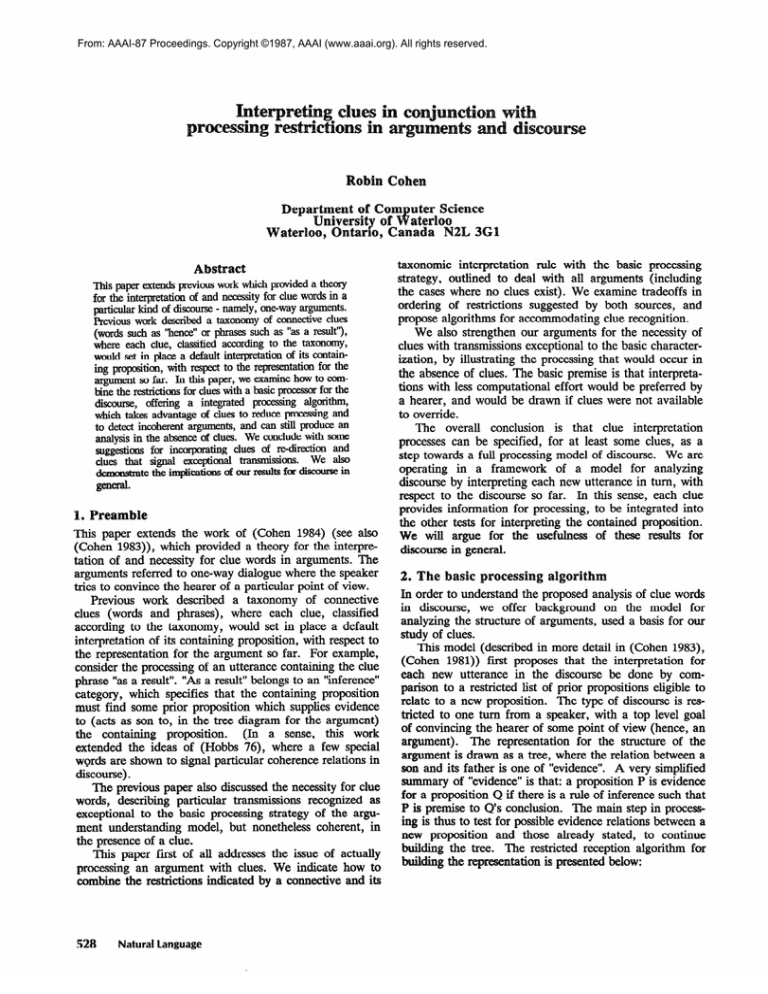
From: AAAI-87 Proceedings. Copyright ©1987, AAAI (www.aaai.org). All rights reserved.
This paper extends previous work which provided a theory
for the interpretation of and necessity for clue words in a
particularkind of discourse - namely, one-way arguments.
Previous work described a taxonomy of cunnective clues
(words such as “hen&’ or phrases such as “as a result”),
where each clue, classified according to the taxonomy,
would set in place a default interpretationof its containing proposition, with respect to the representationfor the
argument so far. In this paper, we examine how to comline the rf2drictionsfor clues with a basic lmnmsor for the
discourse, offering a integrated processing algorithm,
which takes advantage uf clues to reduce processing and
to detect incuherent arguments, and can still produce an
analysis in the absence of clues. We conclude with some
suggestions for incmporating clues of redirection and
clues that signal exceptimal transmissions. We also
demmshatetheim@icatiansdcurresultsfordisccause~
general.
I. Preamble
This paper extends the work of (Cohen 1984) (see also
(Cohen 1983)), which provided a theory for the interpretation of and necessity for clue words in arguments. The
arguments referred to one-way dialogue where the speaker
tries to convince the hearer of a particular point of view.
Previous work described a taxonomy of connective
clues (words and phrases), where each clue, classified
according to the taxonomy, would set in place a default
interpretation of its containing proposition, with respect to
the representation for the argument so far. For example,
consider the processing of an utterance containing the clue
phrase “as a result”. “As a result” belongs to an “inference”
category, which specifies that the containing proposition
must find some prior proposition which supplies evidence
to (acts as son to, in the tree diagram for the argument)
the containing proposition. (In a sense, this work
extended the ideas of (Hobbs 76), where a few special
words are shown to signal particular coherence relations in
discourse).
The previous paper also discussed the necessity for clue
words, describing particular transmissions recognized as
exceptional to the basic processing strategy of the argument understanding model, but nonetheless coherent, in
the presence of a clue.
This paper first of all addresses the issue of actually
processing an argument with clues. We indicate how to
combine the restrictions indicated by a connective and its
528
Natural Language
taxonomic interpretation rule with the basic processing
strategy, outlined to deal with all arguments (including
the cases where no clues exist). We examine tradeoffs in
ordering of restrictions suggested by both sources, and
propose algorithms for accommodating clue recognition.
We also strengthen our arguments for the necessity of
clues with transmissions exceptional to the basic characterization, by illustrating the processing that would occur in
the absence of clues. The basic premise is that interpretations with less computational effort would be preferred by
a hearer, and would be drawn if clues were not available
to override.
The overall conclusion is that clue interpretation
processes can be specified, for at least some clues, as a
step towards a full processing model of discourse. We are
operating in a framework of a model for analyzing
d&course by interpreting each new utterance in turn, with
respect to the discourse so far. In this sense, each clue
provides information for processing, to be integrated into
the other tests for interpreting the contained proposition.
will argue for the usefulness of these results for
discourse in general.
2. The basic psoces
goritkm
In order to understand
posed analysis of clue words
in discourse, we offer background on the model for
analyzing the structure of arguments, used a basis for our
study of clues.
This model (described in more detail in (Cohen 1983))
(Cohen 1981)) first proposes that the interpretation for
each new utterance in the discourse be done by comparison to a restricted list of prior propositions eligible to
relate to a new proposition. The type of discourse is restricted to one turn from a speaker, with a top level goal
of convincing the hearer of some point of view (hence, an
argument). The representation for the structure of the
argument is drawn as a tree, where the relation between a
son and its father is one of “evidence”. A very simplified
summary of “evidence” is that: a proposition P is evidence
for a proposition Q if there is a rule of inference such that
P is premise to Q’s conclusion. The main step in processing is thus to test for possible evidence relations between a
new proposition and those already stated, to continue
g the tree. The restricted reception algorithm for
g the representation is presented below:
L: last eligible node; NEW current proposition
Tree has a dummy root; succeeds as father to all
(used to simulate a stack)
forever do:
if NEW evidence for L then
if no sons of L are evidence for NEW then
/* just test rightmost son for evidence */
attach NEW below L
set L to NEW
exit forever loop
else
attach all sons of L which are evidence
for NEW below NEW
attach NEW below L
exit forever loop
endif
else set L to father (L)
endif
end forever loop
This is termed a hybrid reception, because sub-arguments
may be inserted claim first (pre-order) or claim last
(post-order).
3. Interpreting
EX2: 1) The city has problems
2) The parks are a mess
3) The highways are a mess
4) The buildings are a mess
5) (As for the parks) the benches are broken
6) (And for the highways) there
are potholes in the autoroutes.. .
with a representation, in the absence of clues:
clues
An argument, regardless of presence of clues, is processed
in our model according to some proposed restrictions,
based on recognizing only coherent transmission orderings
from the speaker (as encoded in the algorithm above).
Clue words have been observed to have two functions:
to further restrict processing for the speaker, or to signal
an exceptional transmission, for the hearer to accept
beyond his basic processing strategy. In (Cohen 83) (see
also (Cohen 87)) we argue that only certain kinds of
exceptional strategies should be accepted as well.
The preferred interpretation will always be one where
the basic processing restrictions hold (the hybrid algorithm). To motivate why this is true, consider the example below.
EM:
simply because a more effortless interpretation can bc
recovered as above.
In the absence of a clue word, a coherent interpretation still results, and will be drawn by the model, attempting to satisfy the hybrid constraints. The clue in 4 may
signal a different transmission, acceptable because no eligible candidates will otherwise satisfy the semantic constraints of the clue. (Note that 2 is not eligible to receive
new evidence, since the hybrid algorithm closes off earlier
brothers at a level).
Note as well that with one of the “acceptable exceptional strategies”, absence of clues merely produces a different interpretation to the hearer than the one possibly
intended by the speaker. In the case of a parallel
stmc*e, for example:
1) The park benches are rotting
2) The parks are a mess
3) The highways are run down
4) (Another problem with the parks
is that) the grass is dying
5) This city is iu sad shape
Without the clue in 4, redirecting to proposition 2, to
add more evidence out of turn, a coherent representation
could be built just the same, as below:
x
2 ’ +4
1
If the speaker intends 4 to add detail to 2, he cannot
expect the hearer to recover this structure without a clue,
2%%6
The parallel structure, described in (Cohen 84) as an
exceptional strategy, involves a return to a previously
closed proposition to add evidence, to then add evidence
for each of the brothers of that closed proposition, in
turn. The intended representation of EX2, recognizable
with clues is:
5
/2
/f\,
2
s..
Since following the hybrid algorithm is basically the
preferred interpretation, it makes sense that the restrictions embodied by this algorithm govern the processing of
clues. We will first study particular classes of the taxonomy of connectives and propose “processing mesh with the
hybrid” for each case. We can then reflect on what the
relationship between clue processing and basic search is.
We will discuss clues of redirection (as in EXl) above
briefly after the study of connective clues.
g connective
ches
When clues appear in an argument, these should signal to
the basic processor that additional information is being
provided by the speaker. This information further restricts
the tests for determining the interpretation of the proposition containing the clue. Connective clues provide the
additional information of HOW th
some prior proposition (see the def
Cohen
529
the taxonomy; the categories are drawn from (Quirk 72)).
In the table below, S represents the proposition with the
clue; P is the prior proposition which “connects” to S.
Part of taxonomy of clue words, from (Cohen 83)
category
relation: S to P
example
parallel
detail
inference
summary
brother
son
father
father to
multiple sons
in addition
in particular
as a result
in sum
We envision a general system architecture consisting of
(i) a proposition analyzer, which performs the basic processing algorithm (ii) a clue interpreter, which is called
when a clue is detected, and then controls the proposition
analyzer (iii) an evidence oracle, which is passed two propositions by the proposition analyzer and responds yes or
no whether one is evidence for the other. Since the oracle
has a difficult task, the overall efficiency of processing
would be improved if either calls to the oracle were
avoided, or additional information were available to the
oracle to facilitate its testing. (Note that the “oracle” is
eventually given some specifications, and is more than
just a black box. The processing of the oracle is another
topic altogether; see (Cohen 83) for more details).
Our research on integrating clue interpretation with the
basic processor is still in progress, but we offer the following algorithm as a first version. Note that this algorithm
would then replace the basic processing algorithm
(described in section 2). We will explain the main features
of the algorithm after its listing.
clue1 : true if proposition has a “parallel” clue;
clue2: for detail, clue3: for inference, clue4: for summary
forever do:
/* before testing NEW for L */
if L=dummy then
if clue2 then (( 1))
INTERRUPT-DISCOURSE
endif
endif
/* see if rightmost son exists */
if (clue1 v clue3 v clue4) & no
rightmost son of L then
if L=dunnny then
INTERRUPT-DISCOuRsE
(and exit loop)
else
set L to father of L ((3))
endif
endif
530
Natural Language
(and exit loop)
((2B))
if NEW evidence for L then
/* see if sons will re-attach */
if no sons of L evidence for NEW then
if (clue3 v clue4) then
if L=dummy then
INTERRUPT-DISCOURSE
(( 2))
(and exit loop)
else
set L to father of L
endif
else
/* normal attaching */
attach NEW below L
set L to NEW
exit forever loop
endif
else /* some son wants to re-attach */
attach all sons of L which are
evidence for NEW below NEW
attach NEW below L
exit forever loop
endif
else /* if NEW not evidence for L */
set L to father of L
endif
end forever loop
The first point is that some calls to the evidence oracle
can be avoided, if one follows the restrictions of the clue
interpretation rules for the taxonomy. Consider the following example:
EX3: I) The city is in serious trouble
2) There are some fires going
3) Three separate blazes have broken out
4) In addition, a tornado is passing through
The clue in 4 requires 4 to be a brother of some prior proposition. This is realized in our processing model by finding a father from which an attached son may serve as
brother.
The hybrid algorithm would have 4 first test to be son
to 3 (the last eligible). Since a simple test can confirm
that 3 has no sons, it is not considered at all. Thus, one
possible call has been avoided, due to the presence of the
‘s is illustrated in part ((3)) of the algorithm
fEe)(= .
We now consider incoherent arguments. We can
specify criteria for recognizing an incoherent transmission,
which would then be detected earlier than if the clue did
not exist to constrain the required relationship. For
instance, in the case where we expect a son prior in the
argument, if all tests for father that can also pick up a
son fail (must now be at the dummy top to realize this)
then we can label the argument incoherent and interrupt the expectation of the clue has not been met.
Without a clue, we could expect to find later propositions acting as son to current; as such, we would not
detect incoherence until the end when no common father
exists at the top.
EX4: 1) The parks are a mess
2) The park benches are a mess
3) The playgrounds are a mess
4) The highways are a mess
5) The buildings are a mess
6) The stadiums are a mess
If at this point the argument ended, the analyzer could
detect a lack of top level father to detect incoherence.
EX5: 1) The parks are a mess
2) The park benches are a mess
3) The playgrounds are a mess
4) As a result, the highways are a mess
4 requires a son prior in the discourse. As this fails,
the incoherence of this possibly continuing argument (as
in EX4) would be detected earlier.
This is incorporated into the algorithm in the tests
labelled ((2)).
Both parallel, inference and summary
require a son (either to attach to NEW or serve as a
brother to NEW). If this test cannot be met, the argument is incoherent (see ((29)).
Likewise, if no prior proposition exists to connect to the proposition with a connective clue, regardless of the relationship expected, the
argument is again incoherent and the hearer would interrupt (as in part (( 1))) where a detail clue expects a nondummy father prior in the argument).
Examining when an argument is incoherent is also
important for studying when clues are used to signal
exceptions, rather than just to additionally constrain the
basic hybrid case. So, the clarification of when connectives fail in their default interpretations is important as a
processing indication to then test for exceptional strategies. (The semantics of the clue and the representation
of propositions is also critical; see discussion in section 5).
Are there additional constraints to processing that
clues can provide? One possibility we examined was
whether some connective clues suggest altering the order
of tests performed by the hybrid algorithm. We decided
that the order of nodes visited from the eligible list should
not change (connectives merely indicate HOW, not
WHERE propositions relate). But we examined the
effects of testing for a son before testing to be a son at
any given node in the tree.
To explain, the inference class, for example, requires a
son to be found earlier in the tree. As each eligible node
L is examined, should we test sons of L as son to NEW
before we test NEW son to L?
Our conclusion is that it is costlier to test for sons first.
Defense of this conclusion is offered below.
Here,
The standard algorithm, when we are dealing with a
statement with an inference clue, Cm be stated as follows:
do
if L is-father-of NEW then
attach NEW as son of L
re-attach sons of L below NEW
BREAK
else
set L to father-of(L)
endif
enddo
If we modify this to check first for a son of NEW, then
we have:
do
if NEW is-father-of rightmost-son(L) then
if L is-father-of NEW then
attach NEW as son of L
re-attach sons of L below NEW
BREAK
else
set L to father-of(L)
endif
else
set L to father-of(L)
endif
enddo
Suppose Li is the father to NEW. Under the standard
method the following tests will be performed:
NEW
NEW
...
NEW
NEW
(then
is-evidence-for Ll
is-evidence-for L2
...
is-evidence-for Li-1
is-evidence-for Li
re-attach sons of Li)
->
->
FAIL
FAIL
-> FAIL
-> SUCCEED
If we use the modified algorithm, and test for a son of
NEW first, then we have:
Ll is-evidence-for NEW
NEW is-evidence-for Ll
L2 is-evidence-for NEW
NEW is-evidence-for L2
...
...
Li-1 is-evidence-for NEW
NEW is-evidence-for Li
(then re-attach sons of Li)
->
->
->
->
SUCCEED *
FAIL
SUCCEED *
FALL,
-> SUCCEED
-> SUCCEED
The above tests marked * all succeed because of the
transitive nature of the evidence relationship. That is,
since Li-1 is evidence for NEW, anything which is evidence for Li-1 will also be evidence for NEW. Thus, any
test for an Lj to be a son of NEW (with j C i) will
succeed.
From this we can rewrite the modified algorithm. It is
essentially:
Cohen
531
do
evidence-oracle call which always succeeds
if L is-father-of NEW then
attach NEW as son of L
re-attach sons of L below NEW
BREAK
else
set L to father-of(L)
endif
enddo
Thus, this algorithm will use more evidence oracle calls
than the standard method of checking NEW to be a son
of L first. In fact, trying to find a son of NEW first will
take on the order of twice as many calls. In short, we
adhere to the basic algorithm’s testing of NEW to be son,
before testing to re-attach propositions to be sons of
NEW, regardless of clue.
For the taxonomy classes of detail, inference, summary
and parallel (conjunction type versus list type (first,
secondly, etc.)), we offer the following results: (i) for
these classes, it is not effective to alter the tests at a particular node (ii) it is possible to cut one test to the oracle
(iii) one additional advantage that the connective clues
provide is to detect earlier incoherent arguments from a
speaker (if the expectations associated with the clue are
not satisfied by some prior proposition as required).
5. Re-direction
clues and future work
Clues which redirect the processing should have the following relationship to the hybrid: (i) can alter the order of
nodes visited (ii) unless the clue also has a kind of connective specified, cannot alter the order of testing at a
node or add constraints to the node (i.e. must have sons).
Clues such as “first, secondly, etc.” can now be examined as a redirection indication. They are parallel connectives, expecting brothers prior in the argument, but
they also expect to connect at a particular location namely, at the head of the sub-argument tagged by the
specific clue that is one earlier in the list (e.g. “thirdly”
expects to connect to “secondly”). For future work, this
kind of clue word should be examined to lead in to an
incorporation of re-direction clues into the processing
algorithm.
In general, redirection clues are supposed to provide
some insight into which prior proposition relates to the
one with the clue. Connective clue words only indicate
which relation holds with some prior proposition. It is
worth investigating how the proper prior proposition can
he selected, especially in exceptional cases which override
the eligibles for the hybrid. ‘Ibis research will require a
deeper investigation of the semantic representation for
propositions, used in the analysis.
Another consideration for future work is the role that
clue words have on the work of the oracle. In particular,
if a connective clue carries certain semantic constraints,
how are these precisely communicated to the oracle to
fzd.itate its procasing? The answer is obviously infh-
532
Natural Langwage
enced by the underlying representation used for the
knowledge bases accessed by the oracle and the form of
the propositions, when “parsed”, made available to the
oracle.
We are currently developing an implementation of the
algorithm described here to incorporate clues, together
with upcoming solutions for handljng other kinds of clues,
building on the initial implementation of the basic processor, completed in (Smedley 86).
Refinement of the clue interpretation rules and the
integrated algorithm is another topic for future work. In
(Cohen 83) we offer some motivation for why the
interpretation rules as formulated hold for the associated
class of clues in the taxonomy. In developing an algorithm for implementation, additional constraints and characterizations may occur. We include a brief discussion of
two additional constraints to investigate.
With a clue of the “parallel” category, a brother earlier
in the discourse must be found. (Note: it is still coherent
to have the father not yet appear in the discourse).
According to our integrated algorithm, it is possible for
the proposition with the clue (NEW) to find a father (L)
and to re-attach the sons of L. Some modification to this
test must be made to prevent all the sons of L from
re-attaching, thus leaving no brother for NEW. IIowever, it is worth studying whether re-attachment of sons
of L is in itself a signal of incoherence.
For the “summary” category, more than one son is to
be found earlier in the discourse. So, the integrated algorithm should have an additional test to ensure that when
sons are re-attached, more than one re-attaching occurs.
But what of the case when the son that re-attaches is in
effect a tree, so that there are “multiple sons” for NEW,
but not all at the same level? One interpretation is that
this structure is, as well, incoherent.
The general problem raised by these suggestions for
incoherence is how to consider the interaction between
different types of clue words, when more than clue word
occurs, either within one sentence or between two sentences which are being tested for a relation (e.g. So, for
example.. . or So, next... ). The interacting occurrences
may allow for certain relations to be tested in the
integrated algorithm, which on the surface seem indicators of incoherence. Studying how multiple constraints
may be satisfied is again a topic for future research.
We have provided some new insights into how to incorporate clue interpretation into our model for analyzing
arguments, to mesh with the basic processing restrictions.
In the process, we have discovered some worthwhile properties of clues: (i) they signal overrides to the processing
(for exceptional transmissions) (ii) they provide additional
information on where to process or which relationship to
find in the prior argument (iii) indications of which relation to find do not constrain the basic processor, except to
rule out one test at the last proposition (possibly) or in
cases where the argument is incoherent.
We feel that these results carry over to the case of
discourse analysis in general. If coherence constraints for
processing of discourse are postulated, the clues should
help constrain further. Other researchers have studied the
role of clue words in discourse (e.g. (Reichman 81))
(Grosz and Sidner 85)) (Polyani and Scha 83)). If one
allows a processing of discourse that does not contain
clues, one must comment on how the presence of clues
alters the basic processing. In this paper, we suggest how
a clue interpretation module would constrain the processor
for certain connectives, and point to ongoing work on the
analysis of redirection clues. We also provide insight
into when an argument is considered incoherent, and
when exceptional transmissions are recognizable (when
the clue exists by necessity).
But most of the saving in processing for connectives
should come from demanding more specialized semantic
relationships (the part tested in our model by the oracle).
We have to describe more precisely these operations for
future work, to also gain insight into interpreting
redirection clues. We feel that current studies of intonation as a clue (Hirschberg and Pierrehumbert 86) can be
treated in a similar fashion. We would then propose an
analysis in terms of operations saved, on average, when
clues indicate where to test for relations.
(Hobbs 78) Hobbs, J.; “Why is Discourse Coherent?“; SRI
Technical Note No. 176, 1978.
(Polyani and Scha 83) Polyani, L. and Scha, R.; ‘On the
Recursive Structure of Discourse”; in Connectedness in
Sentence, Discourse and Text, KEhlich and H. van
Riemsdijk, eds., 1983.
(Quirk 72) Quirk, R. et. al.; A Grammar of Contemporary English; Longmans, 1972.
(Reichman 81) Reichman, R.; ‘Plain Speaking: A Theory
and Grammar of Spontaneous Discourse”; BBN Report
NO. 4681, 1981.
(Smedley 86) Smedley, T.; “An Implementation of a
Computational Model for the Analysis of Arguments:
An Introduction to the First Attempt”; University of
Waterloo Department of Computer Science Technical
Report No. CS-86-26, 1986.
Acknowledgements
I am indebted to Trevor Smedley for discussions on this
research and comments on earlier drafts of this paper.
This research was supported by Nserc (Natural Sciences
and Engineering Research Council of Canada).
eferences
(Cohen 81) Cohen, R.; “Investigation of Processing Strategies for the Structural Analysis of Discourse”; Proceedings of ACL81, 1981.
(Cohen 83) Cohen, R.; “A Computational Model for the
Analysis of Arguments“; University of Toronto Computer Systems Research Group Technical Report No.
CSRG-151, 1983. (Ph.D. thesis)
(Cohen 84) Cohen, R.; “A Computational Theory of the
Function of Clue Words in Discourse”; Proceedings of
COLING84, 1984.
(Cohen 87) Cohen, R.; “Analyzing the Structure of
Argumentative Discourse”; to appear in Computational
Linguistics, 1987.
(Grosz and Sidner 85) Grosz, B. and Sidner, C. ; ‘The
Structures of Discourse Structure”; Bolt, Beranek and
Newman (BBN) Report No. 6097, 1985. (also Report
No. CSLI-85-39)
(Hirschberg and Pierrehumbert 86) Hirschberg, J. and
Pierrehumbert, J. ; ‘The Intonational Structure of
Discourse”; Proceedings of ACL86, 1986.
(Hobbs 76) Hobbs, J.; “A Computational Approach to
Discourse Analysis”; City University of New York
Department of Computer Sciences Research Report No.
76-2, 1976.
Cohen
533


